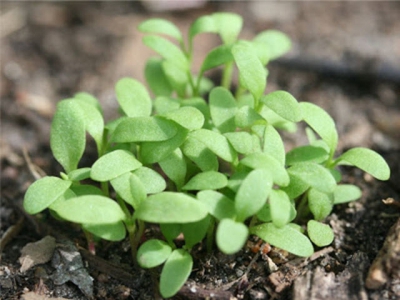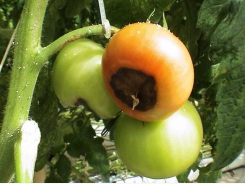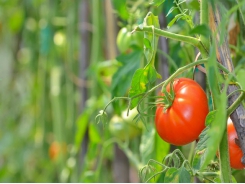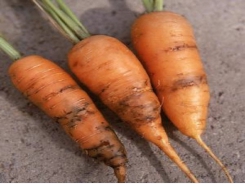Pests and Diseases of Seedlings and Young Plants

It is never easy to identify the cause of seed and seedling failure. Conditions that encourage pests and diseases of seedlings and young plants are those that do not favour plant growth. The best strategy therefore is to give plants a good start so that they grow away quickly, strongly and healthily.
Bean seed fly (Delia platura)
This pest affects beans of all types.
Typical symptoms: Seed fails to emerge and become infested with small white maggots. Losses can be considerable, especially in cold wet seasons when germination is slow.
Prevention and treatment: Raise plants indoors; encourage quick early growth of direct-sown plants. Cover with fleece or polythene.
Cutworm (Noctua spp.; Agrotis spp.)
This pest affects young vegetable plants, especially lettuces and brassicas.
Typical symptoms: Young plants suddenly wilt; the top may be severed from the roots. Fat caterpillars, which may curl up into a crescent shape when disturbed, are sometimes found in the surrounding soil, or on plants at night.
Prevention and treatment: Dig over the site where cutworm has been a problem to encourage birds to eat the pests. Protect individual plants with collars applied when transplanting. These can be made from tins with the top and bottom cut off, sections of plastic drainpipe or the inner tubes from toilet paper rolls. Push the collar a few centimetres down into the soil. Where there is cutworm damage, search the soil around plants and remove any caterpillars. Also examine plants at night and pick off the culprits.
Damping off (Pythium spp., Rhizoctonia spp. And others)
This affects the seedlings of many plants.
Typical symptoms: Seedlings topple over, usually soon after germination, due to the base of their stems withering.
Prevention and treatment: Do not sow into cold, damp soils. A heated propagator will help avoid this problem in a greenhouse. Sow thinly to avoid overcrowding and allow good ventilation. Do not overwater.
Downy mildews
Downy mildews affect the seedlings of brassicas, especially cauliflower, and of lettuce.
Typical symptoms: White furry growth on the underside of leaves and poor growth.
Prevention and treatment: See How to Treat Common Plant Diseases
Mice
Mice will make substantial inroads into peas, beans and sweet corn.
Typical symptoms: Seeds are eaten; individual holes where mice have tunnelled towards the seed appear in the soil. If the seed has germinated it may still be eaten, the shoot itself being left untouched. Damage by mice is worst from autumn to early spring.
Prevention and treatment: Raise early sowings of peas and beans indoors in boxes, pots or gutters and transplant them when the soil has warmed up. Avoid autumn and early spring sowings.
Millipedes (Blaniulus guttulatus and others)
Millipedes attack most seedlings but particularly peas and beans.
Typical symptoms: Poor emergence and survival of seedlings. Millipedes can be seen in the soil.
Prevention and treatment: See General Garden Pests
Poor soil structure
A cloddy seedbed, or one where the soil forms a hard dry crust, will prevent seedlings from emerging.
Typical symptoms: Seedlings fail to emerge in spite of otherwise good conditions and absence of pests.
Prevention and treatment: Hoe and rake to form a fine seedbed before sowing. Cover seed drills with a mixture of soil and leafmould or similar rather than replacing the existing soil. Improve the structure of the surface soil generally by applying mulches of organic matter.
Slugs (Arlon hortensis and others)
Slugs may eat seedlings before, as well as after, they emerge above the soil surface. Slime trails may be seen.
Typical symptoms: Poor emergence of seed if attacked underground; above ground, leaves and growing points are eaten.
Prevention and treatment: See Slugs and Snails – Garden Pest Control.
Wire stem disease (Thanatephorus cucumeris)
Wire stem disease affects seedlings of the brassica family.
Typical symptoms: The base of the stem shrinks to a thin “wire”. Some seedlings may topple over and some larger plants grow poorly.
Prevention and treatment: Sow seed into good soil; do not overwater.
Woodlice (Oniscus asellus and others)
Woodlice can destroy young seedlings and cause damage to young plants by eating the stems and leaves. This tends to be a particular problem with seedlings grown in a greenhouse.
Typical symptoms: Irregular holes appear in leaves and stems may also be chewed or even eaten through at ground level.
Prevention and treatment: Clear up any debris and clutter that provide shelter for the insects. Encourage natural controls including beetles, toads, centipedes and spiders. Do not mulch susceptible young plants, and destroy any woodlice you find congregating under pots, planks, stones and any other nooks and crannies around the garden.
Related news
Tools

Phối trộn thức ăn chăn nuôi

Pha dung dịch thủy canh

Định mức cho tôm ăn

Phối trộn phân bón NPK

Xác định tỷ lệ tôm sống

Chuyển đổi đơn vị phân bón

Xác định công suất sục khí

Chuyển đổi đơn vị tôm

Tính diện tích nhà kính

Tính thể tích ao




 Physiological disorders of tomatoes
Physiological disorders of tomatoes  Pests and Diseases of Carrots, Parsley and Parsnips
Pests and Diseases of Carrots, Parsley and Parsnips